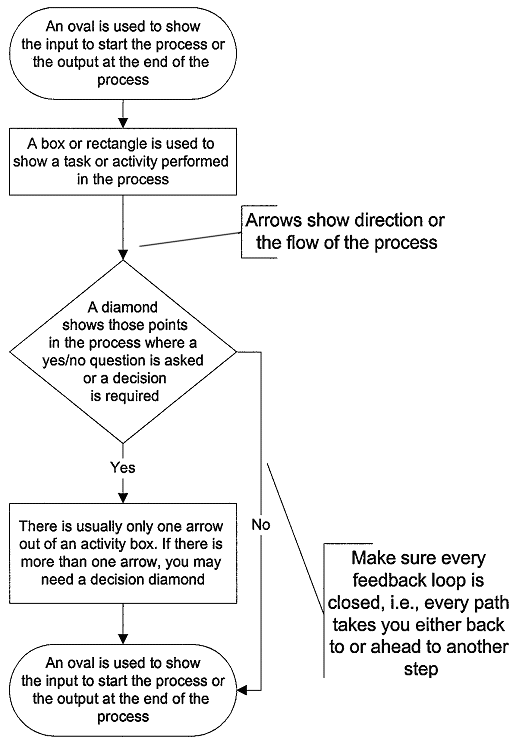Process Mapping
What is Process Mapping?
Process mapping is a workflow diagram to bring forth a clearer understanding of a process or series of parallel processes.
Most organizations that want to move "up a notch" are process mapping using one or more of the following: Deming's Total Quality Management model, International Standard Organization criteria, Goldratt's Theory of Constraints, Baldrige Criteria for Excellence, or the Balanced Score Card.
Constructing a Process Flowchart
Step 1: Determine the Boundaries
- Where does a process begin?
- Where does a process end?
Step 2: List the Steps
- Use a verb to start the task description.
- The flowchart can either show the sufficient information to understand the general process flow or detail every finite action and decision point.
Step 3: Sequence the Steps
- Use post-it notes so you can move tasks.
- Do not draw arrows until later.
Step 4: Draw Appropriate Symbols
- Start with the basic symbols:
- Ovals show input to start the process or output at the end of the process.
- Boxes or rectangles show task or activity performed in the process.
- Arrows show process direction flow.
- Diamonds show points in the process where a yes/no questions are asked or a decision is required.
- Usually there is only one arrow out of an activity box. If there is more than one arrow, you may need a decision diamond.
- If there are feedback arrows, make sure feedback loop is closed; i.e. it should take you back to the input box.
Step 5: System Model
- Draw charts using system model approach.
- Input - use information based upon people, machines, material, method, and environment.
- Process - use subsets of processes in series or parallel.
- Output - use outcomes or desired results.
- Control - use best in class business rules.
- Feedback - use information from surveys or feedback.
Step 6: Check for Completeness
- Include pertinent chart information, using title and date for easy reference.
Step 7: Finalize the Flowchart
- Ask if this process is being run the way it should be.
- Are people following the process as charted?
- Do we have a consensus?
- What is redundant; add what is missing.
The purpose of process mapping is to use diagramming to understand the process we currently use and ask what is expected of us; what should we be doing to provide better customer focus and satisfaction. It will identify what best practices we need to incorporate and find appropriate benchmarks for measuring how we can arrive at better ways of communicating our services. As Dr. George Washington Carver put it: "It is simply service that measures success."
Sample Flowchart

Chris Ahoy, Associate Vice President
Facilities Planning & Management
Iowa State University
From Facilities News, September 1999